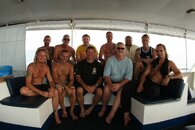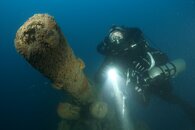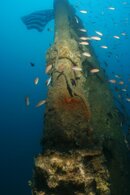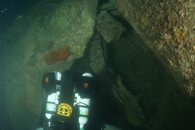Story, Lance Robb
Pictures, Stuey Shaw
The MV Trident usually operates out of Koh Tao and considering the distance we had to travel to get to these wreck sites the boys decided to take the boat to Koh Samui, so we all made our way there to join the boat. That afternoon had us assembling our equipment pumping tanks and generally settling in for the week ahead. That evening around 7.00pm we slipped the lines and we were on our way and motored all night and into mid morning before we arrived at our first mark. We arrived on the position all very excited with most of us in the wheelhouse glued to the sounder looking for the big red lump protruding from the normally flat sandy bottom of the Gulf.
The shot went down and not long after a diver followed it to tie on and shoot a bag if it was a wreck worth diving or he would just surface if it was a pile of junk and we would move on. We all waited anxiously, some guys even got into their equipment hoping to be one of the first to dive this, hopefully, virgin wreck. After what seemed like hours the lift bag appeared and it was time to get kitted up and go take a look at it.
We had a full boat of divers, consisting of 6 Open Circuit divers and 5 Closed Circuit divers (1 Sentinel, 1 Inspo-Deep Pursuit Hybrid, 1 Meg, 1 Hammerhead Meg, 1 Pelagian). We were arranged into buddy teams and our team consisted of 3 CCR divers as we had all dived together previously on another wreck diving trip in the Philippines the year before and were comfortable diving with each other. We met up at the downline at 6 meters and went through our checks before descending down the wreck below. It was later identified as a Japanese Coastal Tanker the Kinrei Maru by the Japanese crockery, size and configuration and more importantly it was not far from the location where the US Submarine the USS Hammerhead had marked her as sunk.
That evening we slipped from the Kinrei Maru and motored over to the location of the only US submarine lost in the Gulf during WW2, the USS Lagarto. We arrived later that night and dropped anchor for the night and would set the shot first thing the following morning.
With the shot set we were all excited to go down and have a look at her.
The first thing to appear out of the dimly lit, murky water was the “Shears”, these are the heavy covers which house and protect the periscopes which are still clearly visible inside. As we stopped and checked our equipment we could see the new USA flag Jamie had just finished tying onto her and it was flying beautifully and made an emotional sight, seeing it flying silently over the grave of the entire crew of 86 still entombed inside the submarine. Down on the bridge Jamie had set up the binoculars which were an integral part of the “Torpedo Data Computer” and fed information directly into the TDC to assist in calculating the range, heading and bearing of the target. It was a high precision machine and one of the US submarine fleets greatest assets and was kept top secret long after the end of the war.
From there we followed the top of the main pressure hull and outer hull to the forward 5 inch deck gun. What really stood out was the immense size and structure of the gun support pedestal. It was massive and would not normally been visible as it would have been below the deck plating, now long gone, leaving masses of pipes you would not have normally seen. The gun sits there silently pointing forward, partially covered with debris from snagged trawl nets and cables but is easily seen
The most impressive sight was the huge indentation on the outer hull just forward and below the forward deck gun. It is a concave indentation approximately 3 meters in diameter and one and a half meters in toward the inner pressure hull. The outer casing is torn open and you can see into where a split in the pressure hull would have been a major contributing factor in sinking her.
From there we went up to the bow where we looked for the open torpedo tube on the stb side. It is open and empty leaving you thinking she went down fighting but never had time to close the outer door before she succumbed to the depth charge attack from the Japanese Navy’s Mine layer, IJN Hatsusaka.
Behind the conning tower one of the machine guns sits on top of the hull parted from the mounting and lying pointing out to the stb side. From here back toward the stern it is very tightly wrapped in trawl nets and cables everywhere and you really need to keep your wits about you or else you could easily get into serious trouble, very quickly. The after deck gun sits on its massive pedestal not unlike that of the forward deck gun except this is a 4 inch gun.
It was decided to only do 2 dives on the Lagarto and continue the search for the location of either of 2 Japanese Merchant wrecks. We were now looking for the Tairyu Maru and the Akita Maru.
As luck would have it the first mark we stopped at produced a big structure sitting on the bottom. When we reached the wreck it was obvious it was big and sitting almost upright. The shotline was secured just aft of the bridge and there were artefacts lying all around the wreck indicating we had found another virgin wreck. I made my way down to the stern where there was a large single barrel deck gun pointing forward somewhere around 4 or 5 inch. It had a rounded stern and one of the other divers said he had seen a very large propeller sticking up out of the sand. We planned to stay for 2 days and leave at the end of the second dive on the second day. After 3 dives on the wreck it was agreed we had found the 5,000 ton freighter the Tairyu Maru. She had been sunk by the Dutch submarine, O-19 on 15 January 1942 and was sitting almost upright.
As fate would have it that was not to be the case! One of my CCR buddies, John, had decided to stay at the wreck slightly longer than Stuey and I. It was no big deal as he was in sight as we went up the shotline and he just wanted to finish rummaging around a small area directly adjacent the line before he joined us on the line. 3 minutes to go at 6 meters and I indicated to Stuey I was going to swim off the line and make my way to the decompression bars located at the back of the boat where the other 2 diver team of CCR divers were finishing off their deco. The deco bars consist of 2 parallel bars spaced at 3 meters and 6 meters and a weight at 9 meters holding them in place directly below the boat. I made it over without a problem and within a minute or 2, I saw Stuey arrive at the 6 meter bar. I looked over and saw John alone on the downline as I expected.
Then unexpectedly a strong current hit us and swang around, and before I knew it, I was shuffling down along the ropes on the end of the bars to the weight at the bottom where I was surprised to find all the divers were now holding onto the weight at the bottom.
I think everyone knows what happened from there on so I won’t bore you again with all the details so I will move on......
Once we had John safely back aboard and we were on our way, we decided to end the trip with a few dives on the Tottori Maru, we would arrive the following morning having motored throughout the night. The Tottori Maru was also sunk by the USS Hammerhead and we dived her the previous year aboard the MV Trident. She was a large ship and is a very impressive wreck and all of us who had previously dived her were all looking forward to visiting her again. We spent the day there and did 2 dives, mostly searching up and around the bow which is almost blown off. She sits settled into the sandy bottom at 74 meters and is listing to stb.
The Tottori was one of the infamous “Hell Ships” responsible for transporting prisoners of war from Singapore to Japan to be put into work camps under the most appalling conditions. She was 6,057 tons, 128 meters long and 17 meters wide and was sunk on 15 May 1945. There were no POWs aboard at the time of sinking.
This had been a fantastic trip where everything had gone well and everyone had totally enjoyed themselves, even John enjoyed it. The only incident we had was when we lost John, it was an extremely serious incident we have all learnt from it and have changed our procedures to ensure it never happens again.
The MV Trident has been booked for a similar trip next year when we hope to find some more new wrecks and once again visit the USS Lagarto and fly another flag from her shears as a mark of respect for those brave souls who sailed in her.
There are still places available for next years trip and is open to suitably qualified divers. Details will be up on Closed Circuit Divers website shortly CLOSED CIRCUIT DIVERS

Divers Back row Left to right. Stu, Jamie, Davoc (Sentinel), Mark, Carl (Pelagian), John (Hammer-Meg)
Front row. Nuts, Micky, Lance (Meg), Stuey (Inspo-Deep Pursuit Hybrid), Miko

Stuey next to the Frd deck gun USS Lagarto

USS Lagarto Periscope Shears with a new USA flag flying

Lance looking at the depth charge damage to the outer hull
Pictures, Stuey Shaw
The MV Trident usually operates out of Koh Tao and considering the distance we had to travel to get to these wreck sites the boys decided to take the boat to Koh Samui, so we all made our way there to join the boat. That afternoon had us assembling our equipment pumping tanks and generally settling in for the week ahead. That evening around 7.00pm we slipped the lines and we were on our way and motored all night and into mid morning before we arrived at our first mark. We arrived on the position all very excited with most of us in the wheelhouse glued to the sounder looking for the big red lump protruding from the normally flat sandy bottom of the Gulf.
The shot went down and not long after a diver followed it to tie on and shoot a bag if it was a wreck worth diving or he would just surface if it was a pile of junk and we would move on. We all waited anxiously, some guys even got into their equipment hoping to be one of the first to dive this, hopefully, virgin wreck. After what seemed like hours the lift bag appeared and it was time to get kitted up and go take a look at it.
We had a full boat of divers, consisting of 6 Open Circuit divers and 5 Closed Circuit divers (1 Sentinel, 1 Inspo-Deep Pursuit Hybrid, 1 Meg, 1 Hammerhead Meg, 1 Pelagian). We were arranged into buddy teams and our team consisted of 3 CCR divers as we had all dived together previously on another wreck diving trip in the Philippines the year before and were comfortable diving with each other. We met up at the downline at 6 meters and went through our checks before descending down the wreck below. It was later identified as a Japanese Coastal Tanker the Kinrei Maru by the Japanese crockery, size and configuration and more importantly it was not far from the location where the US Submarine the USS Hammerhead had marked her as sunk.
That evening we slipped from the Kinrei Maru and motored over to the location of the only US submarine lost in the Gulf during WW2, the USS Lagarto. We arrived later that night and dropped anchor for the night and would set the shot first thing the following morning.
With the shot set we were all excited to go down and have a look at her.
The first thing to appear out of the dimly lit, murky water was the “Shears”, these are the heavy covers which house and protect the periscopes which are still clearly visible inside. As we stopped and checked our equipment we could see the new USA flag Jamie had just finished tying onto her and it was flying beautifully and made an emotional sight, seeing it flying silently over the grave of the entire crew of 86 still entombed inside the submarine. Down on the bridge Jamie had set up the binoculars which were an integral part of the “Torpedo Data Computer” and fed information directly into the TDC to assist in calculating the range, heading and bearing of the target. It was a high precision machine and one of the US submarine fleets greatest assets and was kept top secret long after the end of the war.
From there we followed the top of the main pressure hull and outer hull to the forward 5 inch deck gun. What really stood out was the immense size and structure of the gun support pedestal. It was massive and would not normally been visible as it would have been below the deck plating, now long gone, leaving masses of pipes you would not have normally seen. The gun sits there silently pointing forward, partially covered with debris from snagged trawl nets and cables but is easily seen
The most impressive sight was the huge indentation on the outer hull just forward and below the forward deck gun. It is a concave indentation approximately 3 meters in diameter and one and a half meters in toward the inner pressure hull. The outer casing is torn open and you can see into where a split in the pressure hull would have been a major contributing factor in sinking her.
From there we went up to the bow where we looked for the open torpedo tube on the stb side. It is open and empty leaving you thinking she went down fighting but never had time to close the outer door before she succumbed to the depth charge attack from the Japanese Navy’s Mine layer, IJN Hatsusaka.
Behind the conning tower one of the machine guns sits on top of the hull parted from the mounting and lying pointing out to the stb side. From here back toward the stern it is very tightly wrapped in trawl nets and cables everywhere and you really need to keep your wits about you or else you could easily get into serious trouble, very quickly. The after deck gun sits on its massive pedestal not unlike that of the forward deck gun except this is a 4 inch gun.
It was decided to only do 2 dives on the Lagarto and continue the search for the location of either of 2 Japanese Merchant wrecks. We were now looking for the Tairyu Maru and the Akita Maru.
As luck would have it the first mark we stopped at produced a big structure sitting on the bottom. When we reached the wreck it was obvious it was big and sitting almost upright. The shotline was secured just aft of the bridge and there were artefacts lying all around the wreck indicating we had found another virgin wreck. I made my way down to the stern where there was a large single barrel deck gun pointing forward somewhere around 4 or 5 inch. It had a rounded stern and one of the other divers said he had seen a very large propeller sticking up out of the sand. We planned to stay for 2 days and leave at the end of the second dive on the second day. After 3 dives on the wreck it was agreed we had found the 5,000 ton freighter the Tairyu Maru. She had been sunk by the Dutch submarine, O-19 on 15 January 1942 and was sitting almost upright.
As fate would have it that was not to be the case! One of my CCR buddies, John, had decided to stay at the wreck slightly longer than Stuey and I. It was no big deal as he was in sight as we went up the shotline and he just wanted to finish rummaging around a small area directly adjacent the line before he joined us on the line. 3 minutes to go at 6 meters and I indicated to Stuey I was going to swim off the line and make my way to the decompression bars located at the back of the boat where the other 2 diver team of CCR divers were finishing off their deco. The deco bars consist of 2 parallel bars spaced at 3 meters and 6 meters and a weight at 9 meters holding them in place directly below the boat. I made it over without a problem and within a minute or 2, I saw Stuey arrive at the 6 meter bar. I looked over and saw John alone on the downline as I expected.
Then unexpectedly a strong current hit us and swang around, and before I knew it, I was shuffling down along the ropes on the end of the bars to the weight at the bottom where I was surprised to find all the divers were now holding onto the weight at the bottom.
I think everyone knows what happened from there on so I won’t bore you again with all the details so I will move on......
Once we had John safely back aboard and we were on our way, we decided to end the trip with a few dives on the Tottori Maru, we would arrive the following morning having motored throughout the night. The Tottori Maru was also sunk by the USS Hammerhead and we dived her the previous year aboard the MV Trident. She was a large ship and is a very impressive wreck and all of us who had previously dived her were all looking forward to visiting her again. We spent the day there and did 2 dives, mostly searching up and around the bow which is almost blown off. She sits settled into the sandy bottom at 74 meters and is listing to stb.
The Tottori was one of the infamous “Hell Ships” responsible for transporting prisoners of war from Singapore to Japan to be put into work camps under the most appalling conditions. She was 6,057 tons, 128 meters long and 17 meters wide and was sunk on 15 May 1945. There were no POWs aboard at the time of sinking.
This had been a fantastic trip where everything had gone well and everyone had totally enjoyed themselves, even John enjoyed it. The only incident we had was when we lost John, it was an extremely serious incident we have all learnt from it and have changed our procedures to ensure it never happens again.
The MV Trident has been booked for a similar trip next year when we hope to find some more new wrecks and once again visit the USS Lagarto and fly another flag from her shears as a mark of respect for those brave souls who sailed in her.
There are still places available for next years trip and is open to suitably qualified divers. Details will be up on Closed Circuit Divers website shortly CLOSED CIRCUIT DIVERS

Divers Back row Left to right. Stu, Jamie, Davoc (Sentinel), Mark, Carl (Pelagian), John (Hammer-Meg)
Front row. Nuts, Micky, Lance (Meg), Stuey (Inspo-Deep Pursuit Hybrid), Miko

Stuey next to the Frd deck gun USS Lagarto

USS Lagarto Periscope Shears with a new USA flag flying

Lance looking at the depth charge damage to the outer hull





